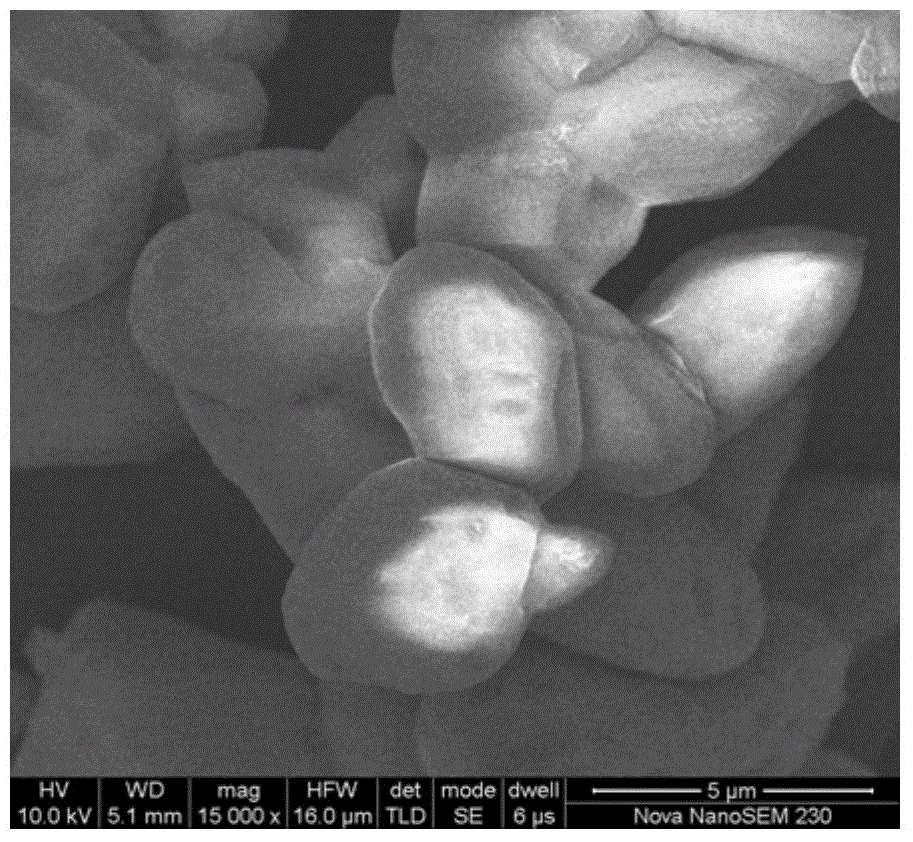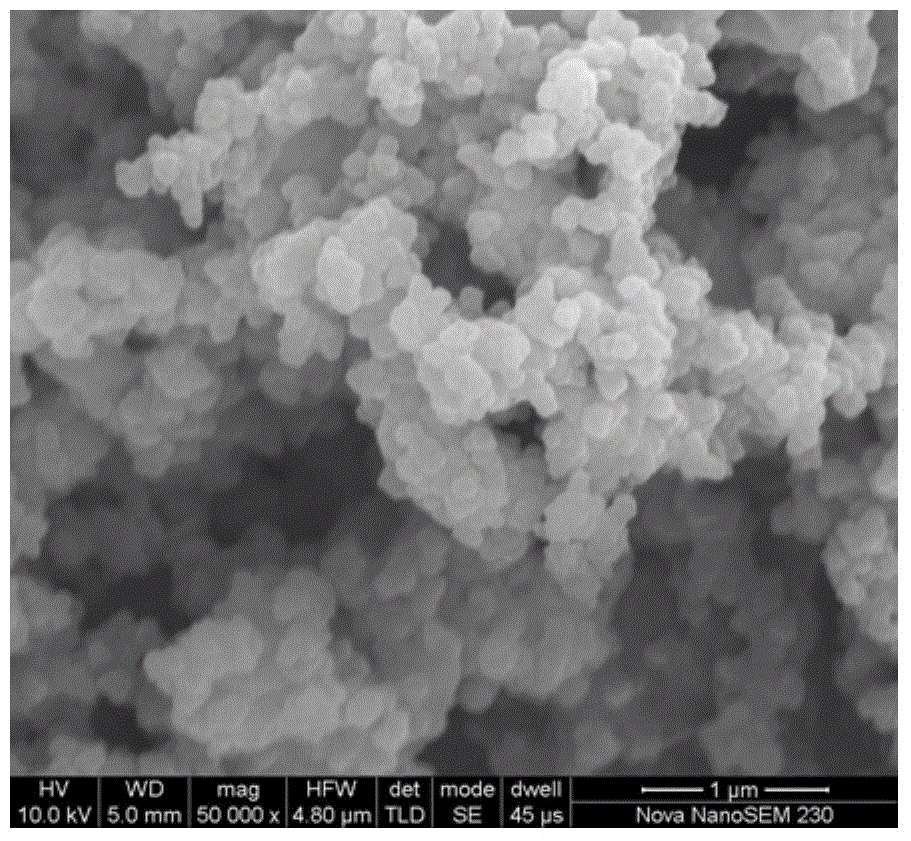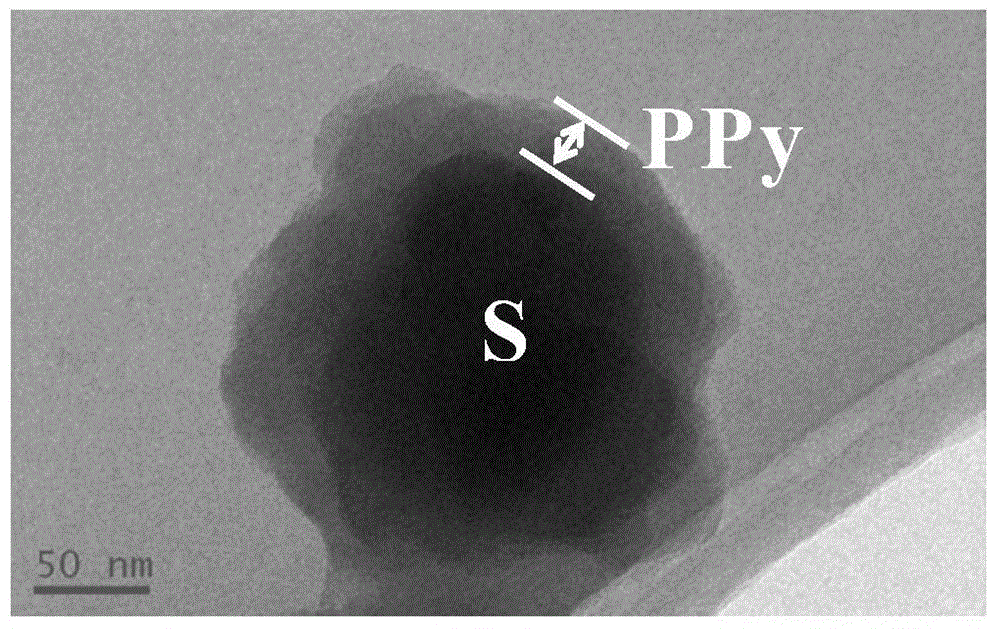Nanometer sulfur-based positive electrode composite material for lithium sulfur batteries, and preparation method thereof
A composite material, lithium-sulfur battery technology, applied in the field of electrochemical energy and nano-materials, can solve the problems of poor electronic conductivity and ion conductivity, a large amount of organic solvents and surfactants, and the reduction of sulfur utilization rate of active substances, etc., to improve The effect of conductivity, improvement of electrochemical performance, and fast chemical reaction rate
- Summary
- Abstract
- Description
- Claims
- Application Information
AI Technical Summary
Problems solved by technology
Method used
Image
Examples
Embodiment 1
[0049] At 25°C, take 3.4901g of sodium thiosulfate pentahydrate and completely dissolve it in 250mL of deionized water, add 2 drops of 3wt% Triton X-100, and after ultrasonic dispersion for 10min, transfer the obtained clear reaction solution into a constant temperature water bath at 70°C 20mL of concentrated hydrochloric acid was dissolved in 1.5mL min under continuous stirring -1 Add the above reaction solution at a high speed until the solution is acidic (pH ≤ 2), continue to stir and keep warm for 2 hours, then transfer the obtained elemental sulfur solution into an ice-bath reactor at 0-5°C, and add 0.1 mL of pyrrole, after continuous stirring for 25 minutes, 0.4132 g of ammonium persulfate was added at one time to fully react for 8 hours, and the obtained core-shell sulfur-polypyrrole nanoparticle solution was ready for use. Graphene oxide prepared by the Hummers method was diluted to 0.65 mg mL with deionized water -1 And ultrasonically dispersed for 2 hours, under the...
Embodiment 2
[0052] At 25°C, take 3.2873g of sodium thiosulfate pentahydrate and completely dissolve it in 200mL of deionized water, add 2 drops of 2wt% PVP, and ultrasonically disperse for 10 minutes, then transfer the obtained clear reaction solution into a constant temperature water bath at 70°C, and continuously With stirring, 20 mL of concentrated hydrochloric acid was dissolved in 1.5 mL min -1 Add the above reaction solution at a high speed until the solution is acidic (pH ≤ 2), continue to stir and keep warm for 2 hours, then transfer the obtained elemental sulfur solution into an ice bath reactor at 0-5°C, and add 0.2 After stirring continuously for 20 min, add 0.5317 g of potassium persulfate to fully react for 7 h, and the obtained core-shell sulfur-polyaniline nanoparticle solution is ready for use. Graphene oxide prepared by the Hummers method was diluted to 1.2 mg mL with deionized water -1 And ultrasonically dispersed for 2 hours, under the condition of constant stirring, t...
Embodiment 3
[0055] At 25°C, take 3.4901g of sodium thiosulfate pentahydrate and completely dissolve it in 300mL of deionized water, add 2 drops of 3wt% Triton X-100, ultrasonically disperse it for 10min, then transfer the obtained clear reaction solution into a constant temperature water bath at 70°C In 1 mL min of 15 mL of concentrated hydrochloric acid with continuous stirring -1 Add the above reaction solution at a high speed until the solution is acidic (pH ≤ 2), continue to stir and keep warm for 2 hours, then transfer the obtained elemental sulfur solution into an ice-bath reactor at 0-5°C, and add 0.1 mL of pyrrole, after continuous stirring for 15 minutes, 0.3756 g of ammonium persulfate was added at one time to fully react for 6 hours, and the obtained core-shell sulfur-polypyrrole nanoparticle solution was ready for use. Graphene oxide prepared by the Hummers method was diluted to 1.85 mg mL with deionized water -1 And ultrasonically dispersed for 2 hours, under the condition o...
PUM
| Property | Measurement | Unit |
|---|---|---|
| Particle size | aaaaa | aaaaa |
| Thickness | aaaaa | aaaaa |
| Diameter | aaaaa | aaaaa |
Abstract
Description
Claims
Application Information
 Login to View More
Login to View More - R&D
- Intellectual Property
- Life Sciences
- Materials
- Tech Scout
- Unparalleled Data Quality
- Higher Quality Content
- 60% Fewer Hallucinations
Browse by: Latest US Patents, China's latest patents, Technical Efficacy Thesaurus, Application Domain, Technology Topic, Popular Technical Reports.
© 2025 PatSnap. All rights reserved.Legal|Privacy policy|Modern Slavery Act Transparency Statement|Sitemap|About US| Contact US: help@patsnap.com



